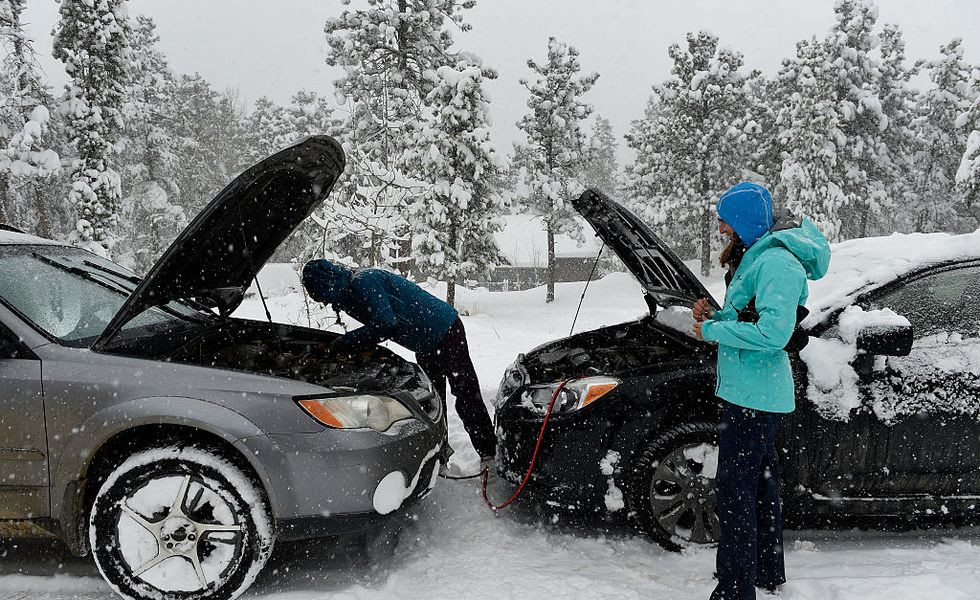As winter sets in, drivers face a unique set of challenges brought on by the harsh conditions of the season. From icy roads to subzero temperatures that can strain a vehicle's mechanical systems, being prepared is crucial. At Get Drivers Ed, we're dedicated to educating drivers on the importance of understanding these winter challenges. We equip them with the necessary skills for safe and effective winter driving. Below, we explore common issues that arise in cold weather and offer detailed guidance on how to manage them.
1. Battery Issues
The cold has a notorious effect on car batteries. Lower temperatures can greatly reduce the efficiency of the chemical reactions within a battery that generate electrical power, thus diminishing its ability to hold a charge. This often results in the unpleasant surprise of a car that won’t start on a cold morning.
Prevention Tip from Get Drivers Ed: To avoid being stranded, test your battery and charging system as winter approaches. Car batteries typically have a lifespan of three to five years; if yours is nearing this age or shows signs of weakness, it might be safer to replace it preemptively. Also, keeping the battery connections clean and free from corrosion can help maintain its efficiency.
2. Thickening Fluids
Your car relies on several key fluids to operate smoothly, including engine oil, transmission fluid, and brake fluid. In cold weather, these fluids can thicken and circulate more slowly, which forces the engine to work harder and less efficiently, potentially leading to increased wear and tear.
Get Drivers Ed Suggestion: Before winter starts, switch to a lower viscosity oil that is better suited for cold weather (often referred to as winter-grade oil). This change will help maintain proper fluid flow and engine lubrication. Check your owner’s manual for manufacturer recommendations regarding oil viscosity for different temperatures.
3. Tire Pressure Fluctuations
For every 10 degrees drop in temperature, tire pressure typically goes down by about 1 psi. Low tire pressure can degrade fuel efficiency, reduce traction, and increase tire wear, particularly dangerous in icy or snowy conditions.
Advice from Get Drivers Ed: Regular checks of your tire pressure are essential during winter. Keeping tires inflated to the manufacturer’s recommended levels ensures optimal contact with the road, improving safety and vehicle handling. Investing in a good-quality tire pressure gauge and checking levels monthly, or even weekly in fluctuating temperatures, can save you from tire troubles.
4. Frozen Fuel Lines
Water vapor in your fuel line can freeze when temperatures fall, potentially blocking the flow of fuel to the engine and preventing your vehicle from starting.
Get Drivers Ed Tip: Keeping your gas tank at least half full can help avoid this problem. A fuller tank will have less air, which means less moisture that can condense and freeze. Additionally, using a fuel additive that absorbs moisture can also be beneficial.
5. Wiper Blades and Windshield Washer Fluid Issues
In freezing conditions, wiper blades can become stiff and brittle, and washer fluid can freeze, both reducing your ability to maintain clear visibility.
Solution by Get Drivers Ed: Install heavy-duty winter wiper blades designed to withstand icy conditions. Fill your washer reservoir with a fluid that has antifreeze properties to prevent it from freezing. Always scrape ice and snow off the windshield before using your wipers to avoid damaging the blades.
6. Frozen Door Locks and Seals
Moisture in the locks or door seals can freeze, making it difficult or impossible to open or securely close your car doors.
Helpful Hint from Get Drivers Ed: Spray a moisture-displacing lubricant into the locks and along the door seals. This can prevent water from entering and freezing. Keeping a lock de-icer handy but outside your vehicle (like in a purse or at work) can also save the day if the locks freeze.
Conclusion
Winter driving demands extra preparation and vigilance. By understanding how to address common vehicle issues in cold weather, you can enhance your safety and ease of driving. At Get Drivers Ed, our comprehensive driver education courses are designed to prepare you for any driving condition, including the challenges of winter. Enroll today at https://getdriversed.com/contexts/online to ensure you’re equipped to handle whatever the cold season may bring your way, with confidence and knowledge.

